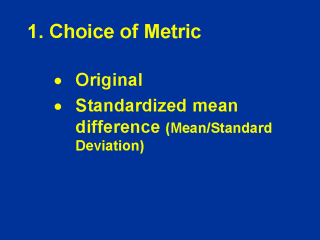 |
In general, the metric used
should be the one that has the most meaning to the reader and will allow for the inclusion
of the greatest number of studies. Whenever possible, the original metric should be used,
for example, changes in resting blood pressure in mmHg, odds ratio, relative risk, etc.
(See: Kelley GA, Tran ZV. Original metric vs. standardized effect sizes for meta-analysis
of clinical data. Preventive Cardiology 4:40-45, 2001). However, in many areas,
such as psychology, various instruments using different metrics are used to assess the
same outcome. In this case, the standardized effect size, similar to a z-score, should be
used. In addition, different test statistics (t-tests, F, etc.) can be converted into a
standardized effect size if outcome data are missing. |
